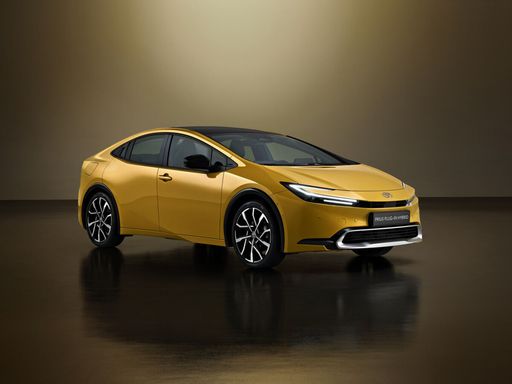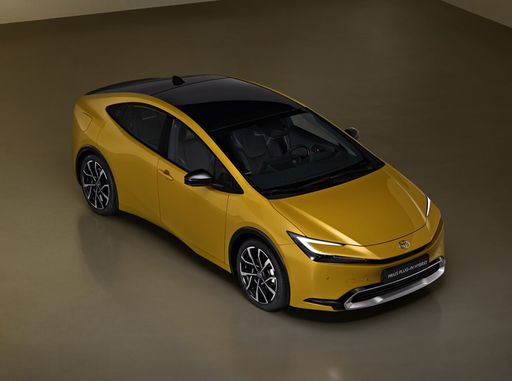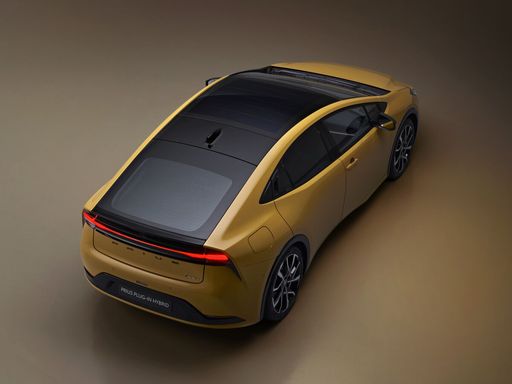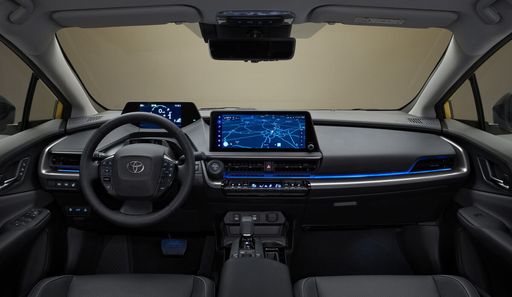Isuzu D-Max vs Toyota Prius – Differences & prices compared
Compare performance, boot space, consumption and price in one view.
Find out now: which car is the better choice for you – Isuzu D-Max or Toyota Prius?
The Isuzu D-Max (Pickup) comes with a Diesel engine and Automatic transmission. In comparison, the Toyota Prius (Hatchback) features a Plugin Hybrid engine with Automatic transmission.
When it comes to boot capacity, the Isuzu D-Max offers , while the Toyota Prius provides 284 L – depending on how much space you need. If you’re looking for more power, decide whether the 163 HP of the Isuzu D-Max or the 223 HP of the Toyota Prius suits your needs better.
In terms of consumption, the values are 8.70 L per 100 km for the Isuzu D-Max, and 0.50 L for the Toyota Prius.
Price-wise, the Isuzu D-Max starts at 34300 £, while the Toyota Prius is available from 39400 £. Compare all the details and find out which model fits your lifestyle best!
Isuzu D-Max
The Isuzu D-Max stands out in the pickup truck market with its robust design and impressive durability, making it a reliable choice for both work and leisure. Its interior blends practicality with a touch of comfort, featuring user-friendly technology that enhances the driving experience. This vehicle's off-road capabilities and strong performance make it a versatile companion for tackling a variety of terrains.
detailsToyota Prius
The Toyota Prius stands as a pioneer in the realm of hybrid vehicles, offering an eco-friendly driving alternative with its innovative technology. Its aerodynamic design and comfortable interior make it a practical choice for those looking to reduce their carbon footprint without sacrificing style. Additionally, the Prius boasts a reputation for reliability and efficiency, contributing to its lasting popularity among environmentally conscious drivers.
details @ Toyota
@ Toyota
 @ Toyota
@ Toyota
 @ Toyota
@ Toyota
 @ Toyota
@ Toyota

|
|
|
|
|
Costs and Consumption |
|
|---|---|
|
Price
34300 - 50100 £
|
Price
39400 - 45800 £
|
|
Consumption L/100km
8.7 - 9 L
|
Consumption L/100km
0.5 - 0.7 L
|
|
Consumption kWh/100km
-
|
Consumption kWh/100km
-
|
|
Electric Range
-
|
Electric Range
72 - 86 km
|
|
Battery Capacity
-
|
Battery Capacity
-
|
|
co2
228 - 235 g/km
|
co2
12 - 17 g/km
|
|
Fuel tank capacity
76 L
|
Fuel tank capacity
40 L
|
Dimensions and Body |
|
|---|---|
|
Body Type
Pickup
|
Body Type
Hatchback
|
|
Seats
2 - 5
|
Seats
5
|
|
Doors
2 - 4
|
Doors
5
|
|
Curb weight
1905 - 2115 kg
|
Curb weight
1620 - 1630 kg
|
|
Trunk capacity
-
|
Trunk capacity
284 L
|
|
Length
5280 - 5320 mm
|
Length
4599 mm
|
|
Width
1810 - 1870 mm
|
Width
1782 mm
|
|
Height
1770 - 1790 mm
|
Height
1470 mm
|
|
Payload
985 - 1095 kg
|
Payload
365 - 375 kg
|
Engine and Performance |
|
|---|---|
|
Engine Type
Diesel
|
Engine Type
Plugin Hybrid
|
|
Transmission
Automatic
|
Transmission
Automatic
|
|
Transmission Detail
Automatic Gearbox
|
Transmission Detail
-
|
|
Drive Type
All-Wheel Drive
|
Drive Type
Front-Wheel Drive
|
|
Power HP
163 HP
|
Power HP
223 HP
|
|
Acceleration 0-100km/h
12.60 s
|
Acceleration 0-100km/h
6.80 s
|
|
Max Speed
180 km/h
|
Max Speed
177 km/h
|
|
Torque
360 Nm
|
Torque
-
|
|
Number of Cylinders
4
|
Number of Cylinders
4
|
|
Power kW
120 kW
|
Power kW
164 kW
|
|
Engine capacity
1898 cm3
|
Engine capacity
1998 cm3
|
General |
|
|---|---|
|
Model Year
2024 - 2025
|
Model Year
2023
|
|
CO2 Efficiency Class
G
|
CO2 Efficiency Class
B
|
|
Brand
Isuzu
|
Brand
Toyota
|
Isuzu D-Max
The Powerhouse on Wheels: An Overview of the Isuzu D-Max
When it comes to robust and reliable pick-up trucks, the Isuzu D-Max stands out as a formidable contender. With its range of versatile models and a reputation for toughness, the D-Max caters to the needs of both commercial users and off-road adventurers. This article delves into the technical details and innovative features that make the Isuzu D-Max a leader in its class.
Under the Bonnet: Performance and Specifications
At the heart of the Isuzu D-Max lies a 1.9-litre turbocharged diesel engine, producing a power output of 163 PS (120 kW) and a torque of 360 Nm. This robust engine is paired with either a six-speed manual or a six-speed automatic transmission, offering flexibility and control for diverse driving conditions. With a top speed of 180 km/h, the D-Max balances power and performance, making it well-suited for both urban environments and rugged terrains.
Efficiency and Eco-Standards
Fuel efficiency is a pivotal factor for many buyers, and the Isuzu D-Max delivers with a consumption ranging from 8.1 to 9.2 L/100km. Despite its impressive capabilities, the D-Max falls into CO2 efficiency class G, with emissions between 212 and 241 g/km. While this places it towards the higher end of the emissions spectrum, its efficiency is commendable considering its size and power.
Innovative Features and Driver Comfort
Isuzu has integrated numerous innovative features in the D-Max, enhancing both functionality and driver comfort. The pick-up is available in several configurations, including single, space, and double cab options with seating arrangements for 2 to 5 passengers. Equipped with state-of-the-art safety technologies and infotainment systems, the D-Max ensures a comfortable and secure ride. Various trim levels, from L 2WD to V-Cross 4WD Automatik, provide options for different preferences and requirements.
Design and Dimensions
The Isuzu D-Max's design is as practical as it is imposing. Measuring between 5270 mm to 5310 mm in length and 1810 mm to 1870 mm in width, with a height of 1770 mm to 1790 mm, it offers a commanding road presence. Its substantial payload capacity ranges from 995 kg to an impressive 1130 kg, making it an ideal choice for heavy-duty operations.
Pricing and Market Position
The Isuzu D-Max is competitively priced within the range of 35,765€ to 56,765€, illustrating its value proposition in the pick-up truck market. It caters to varied customer needs with an extensive line-up and competitive pricing, thereby solidifying its position as a top choice for those seeking a reliable and durable pick-up.
Conclusion: A Vehicle Built for Versatility
The Isuzu D-Max is more than just a workhorse; it is a testament to engineering capable of blending power, practicality, and innovation. Its enduring appeal lies in its versatility and robust performance, making it a popular choice across different demographics and industries.
Toyota Prius
The All-New Toyota Prius: Revolutionising Efficiency and Performance
The Toyota Prius, a name synonymous with hybrid innovation, has once again shown why it remains at the forefront of eco-friendly automotive technology. The latest models have enhanced technical features and innovations, setting new standards for efficiency and driving experience.
Hybrid Performance: A Leap Forward
The latest Prius models employ a sophisticated 2.0 litre Plug-in Hybrid system that flawlessly melds petrol and electric power. With a power output of 223 PS, it propels the Prius with impressive dynamism, reaching 0-100 km/h in just 6.8 seconds. This performance-oriented aspect of the Prius does not compromise on efficiency, with an astonishing fuel consumption ranging from 0.5 to 0.7 L/100km.
Electric Range and Efficiency
One of the key highlights of the new Prius is its substantial electric-only range. Depending on the variant, it can travel between 72 to 86 km on electric power alone, making it an ideal choice for urban commutes where zero emissions are preferred. The hybrid system's CO2 emissions are remarkably low, between 12 and 17 g/km, contributing to its CO2 Efficiency Class B rating.
Engineering Excellence with CVT
The Prius is equipped with a state-of-the-art Continuously Variable Transmission (CVT), ensuring a smooth and efficient drive. This advanced transmission supports the front-wheel-drive layout, delivering power seamlessly and enhancing driving pleasure without sacrificing fuel economy.
Stylish Design and Comfort
Designed as a sleek five-door hatchback, the Prius offers a comfortable and spacious interior with seating for five passengers. It measures 4599 mm in length, 1782 mm in width, and 1470 mm in height, offering a practical balance of size and comfort. The boot space, while tailored for the hybrid battery, still provides a decent 284 litres of storage.
Cost Efficiency
The running costs of the Prius are competitive, with monthly expenses estimated between €1064 and €1188, and cost per kilometre ranging from 42.6 to 47.5 cents. Its efficient design results in a maximum speed of 177 km/h and a practical fuel tank size of 40 litres, ensuring less frequent stops on longer journeys.
Conclusion: The Prius Legacy Continues
The Toyota Prius continues to lead by example in the realm of hybrid technology. Combining impressive power with unmatched efficiency and a sophisticated driving experience, it is clear that the Prius remains a compelling choice for the environmentally conscious driver. Its innovative features and favourable cost metrics only bolster its appeal in the modern automotive landscape.
The prices and data displayed are estimates based on German list prices and may vary by country. This information is not legally binding.
